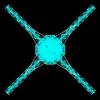Leaderboard
Popular Content
Showing content with the highest reputation on 02/19/15 in all areas
-

Portal Frame
Waqar Saleem and one other reacted to EngrUzair for a topic
W/assalam! You may use following steps to check deflection of a portal frame in SAP2000 (I am assuming that you are using SAP2000 version 14. Other versions might require somewhat different approach.) 1. Run SAP2000 model of your portal frame, using 'Analyze--> Run analysis' menu option. 2. Select 'Show deformed shape...' from 'Display' menu drop down option. Alternately, you may use F6 function key to display 'Deformed Shape' options window. 3. Select the Load 'case / combo' for which you want to check deflection, and press 'OK' command button. Deformed shape of structure for the selected load case will be displayed. 4. Placing the cursor on one of the member joints, will display deflections and rotations at the selected joint, in length units visible at bottom right hand corner of display window. (You will have to make the joints visible, if these are not already in view.) HTH Regards.2 points -
What is your question?1 point
-

How To Apply For A Job?
Waqar Saleem reacted to EngrUzair for a topic
W/Assalam! Taimur! You may apply for employment in two ways: 1. Where an advertisement has been given for the job Method of applying for the job, as well as what information is to be provided with the job application, in normally provided in the advertisement. So, in this case, you should follow the procedure specified in the advertisement. 2. When you want to apply on your own (without any advertisement) It would be better to apply with your CV, supported by photocopies of your educational degree (Matric onwards), and any experience or special skills certificates (e.g., computer , CAD, or civil engineering related software courses etc.). As regards the cover letter, do a search on the internet. you will certainly find some good tips (may be some good book too) regarding how to write a good CV/resume, and what should be included in a cover letter. Best of luck. Regards.1 point -
Assalam-o-alaikum! start of professional career as an engineer, in the USA, is not a simple and easy process. Although actual requirements may vary somewhat from state to state, but generally a four-step process has to be followed for obtaining license to work as an independent professional engineer. (See the thread: http://www.sepakistan.com/topic/1610-benefits-of-getting-pe- licence/#entry3958, for learning the benefits of having a PE license.) Step 1: Graduating from an accredited engineering program (e.g., B.E./B.S./M.S in Civil Engineering,...) Step 2: Passing 'Fundamentals of Engineering' (FE) exam (Details available at: http://ncees.org/exams/fe-exam/) and to become eligible for being classified as an intern, also known as Engineering Intern (EI) or Engineer-in-Training (EIT). Step 3: Obtaining required length of work experience relevant to chosen engineering discipline, after passing the FE exam. In many cases, the experience period is to be supervised by a licensed engineer, depending upon specific requirements of concerned State Licensing Board. Step 4: Passing 'Principles and Practice of Engineering' (PE) exam. Once an engineer has successfully completed the first three steps of this process, he/she may take the second exam in the licensing - the Principles and Practice of Engineering (PE) exam. The PE exam tests the ability of an engineer to practice competently in a particular engineering discipline. It is designed for engineers who have gained at least four years’ post-college work experience in their chosen engineering discipline. Each PE exam has a total duration of 8 hours, and is split into a morning and an afternoon session. PE exam specifications and design standards, applicable for the forthcoming exam are posted on NCEES web site, 6 months before the exam date. Updates for April exams are posted in November, and updates for October exams are posted in May. The specifications and details of design standards for PE Exams 2015, related to five (5) Civil Engineering disciplines, are available at following links: Civil - Construction (https://cdn.ncees.org/wp-content/uploads/2012/11/Civ-Con-April-2015_Combined.pdf) Civil - Geotechnical (https://cdn.ncees.org/wp-content/uploads/2012/11/Civ-Geo-April-2015_Combined2.pdf) Civil - Structural (https://cdn.ncees.org/wp-content/uploads/2012/11/Civ-Str-April-2015_Combined2.pdf) Civil - Transportation (https://cdn.ncees.org/wp-content/uploads/2012/11/Civ-Tran-April-2015_Combined.pdf) Civil - Water Resources and Environmental (https://cdn.ncees.org/wp-content/uploads/2012/11/Civ-WRE-April-2015_Combined.pdf) The PE exam is an open-book exam. The examinees are allowed to bring reference materials to the exam, provided they are bound and remain bound during the exam. Further details regarding PE exam can be found at: http://ncees.org/exams/pe-exam/ The design codes and manuals referred in these documents, are the ones to be followed all across the US, for the structural design of all kind of engineered structures. As such, these are the most important references, a civil or structural engineer (working in a jurisdiction, where US design codes are the basis of engineering design) will need to know, learn, and follow in his/her engineering design practice. Hopefully, this information will not only be beneficial for those, interested in taking the PE exam in near future, but would also help us improve our knowledge and understanding of code requirements regarding design and construction of various kind of civil engineering works. This, in turn, will make our structures safer as well as more code-compliant. Regards.1 point
This leaderboard is set to Edmonton/GMT-06:00
